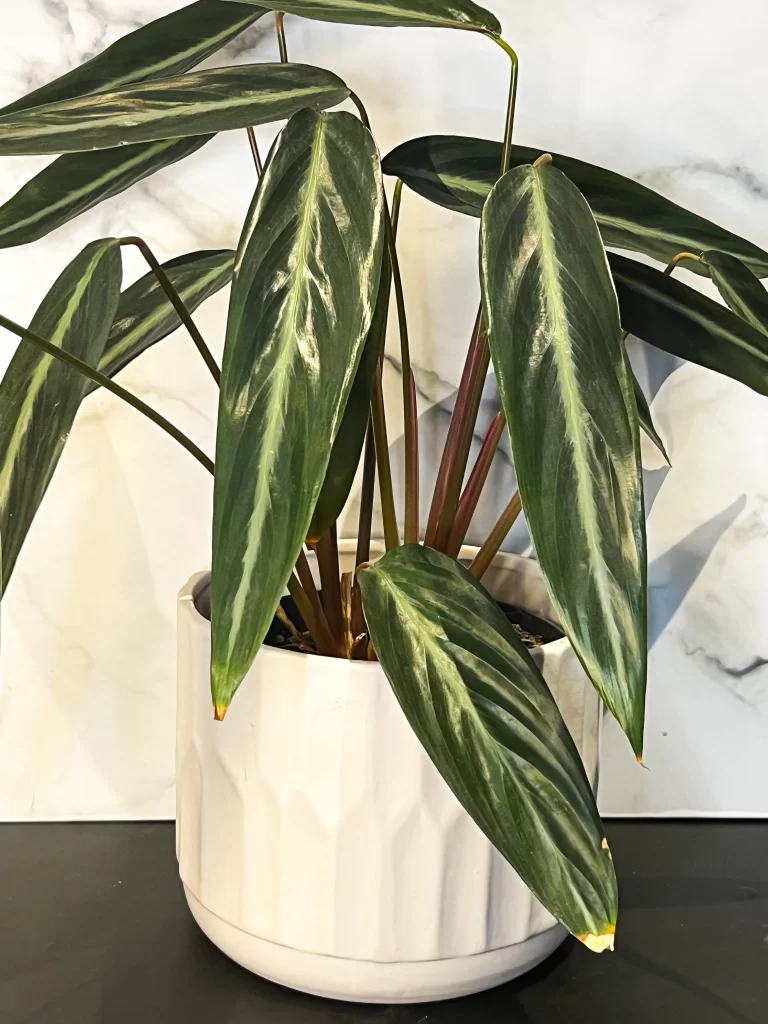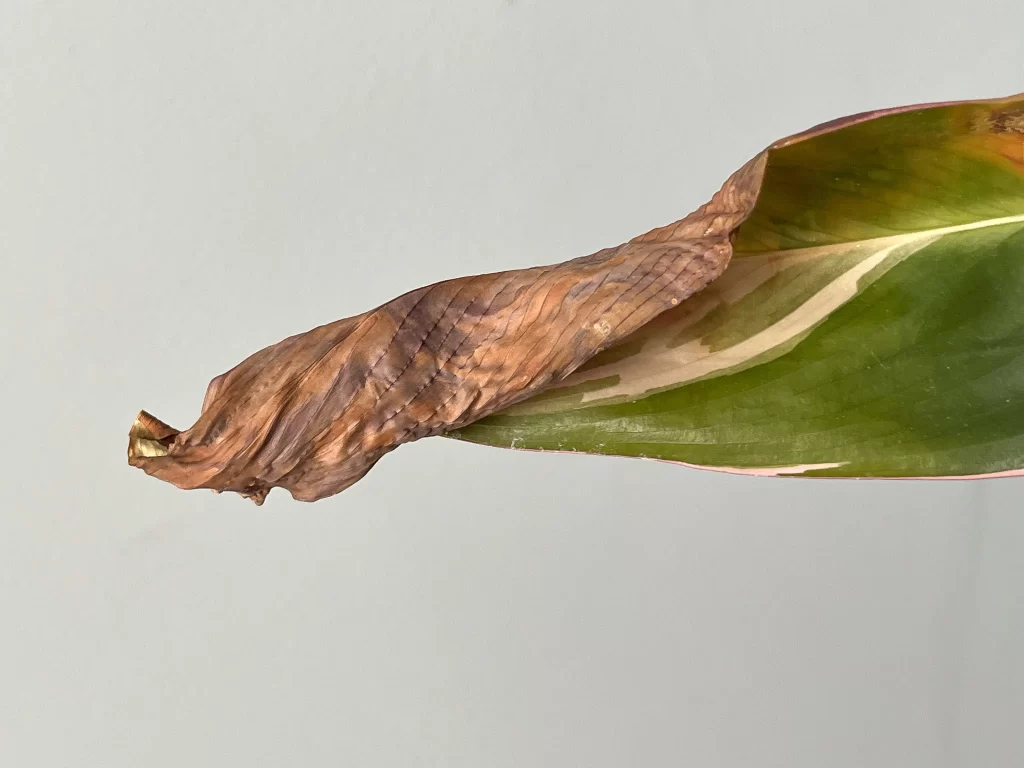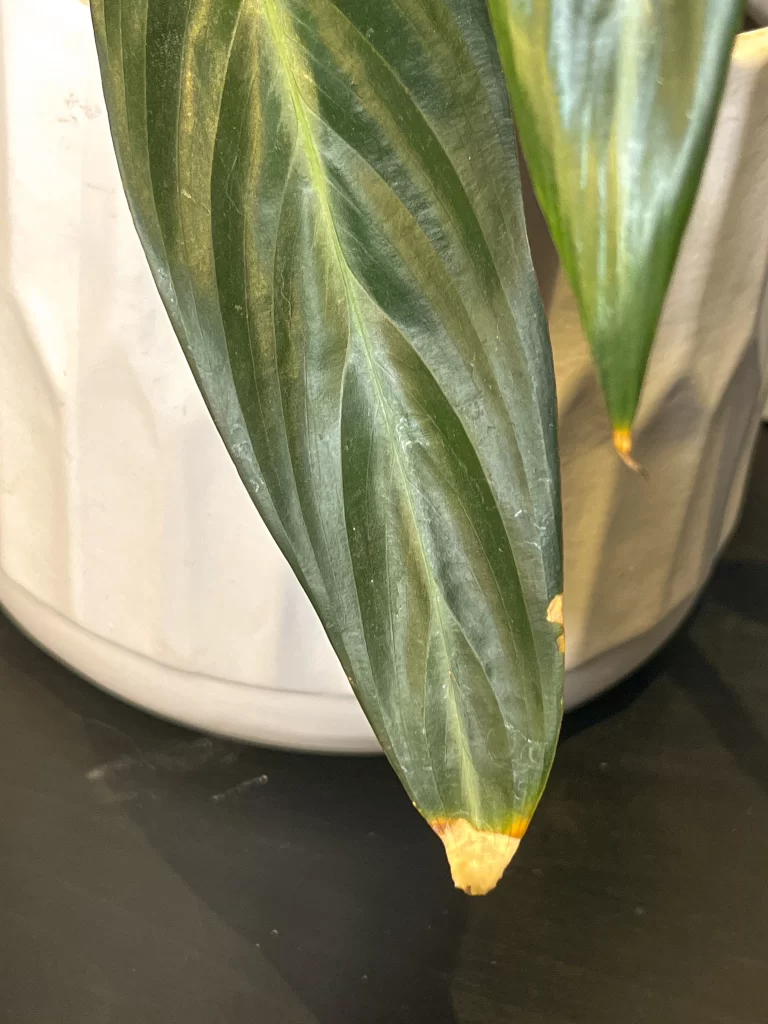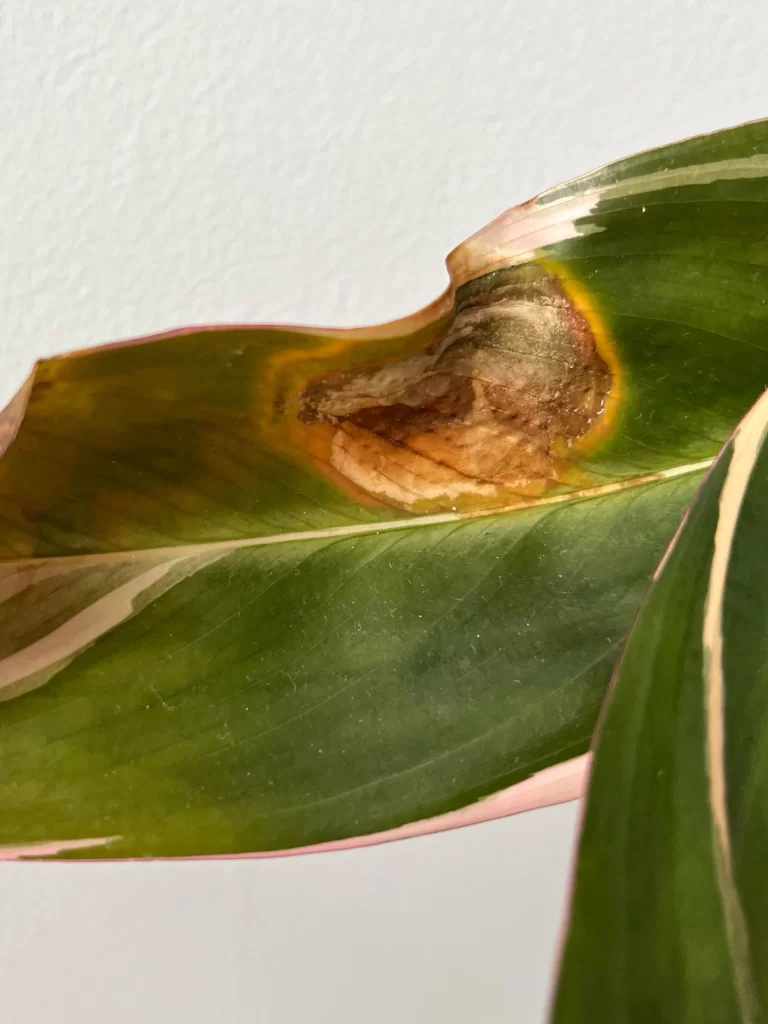
Why Does My Stromanthe Have Brown Tips?
If you’ve ever seen a Stromanthe houseplant, whether the jaw-dropping Triostar, the stunning Magicstar, or even the regular green Sanguinea species, you know the foliage is the star of the show. It’s what catches your eye at the garden center, causing you to yell, “I need this houseplant! Immediately!”
Well, at least it did for me.
So, if you notice that your Stromanthe’s beautiful foliage has brown or maybe crispy tips on the leaves, it’s a huge disappointment. What went wrong here?
The most likely reason your Stromanthe has brown tips is a moisture issue: whether it is a lack of humidity, how often you water it (or don’t water it), or what kind of water you use. Aside from that, you may be dealing with a pest issue, a fungal disease, or even a chemical or sunburn.
Examining the leaf’s appearance and other environmental factors, such as the soil, water, and light conditions, will help you determine which particular cause is causing the browning.
Identifying the source of the problem is the hardest part, but once you do, you can fix it. Let’s look at why your Stromanthe has brown tips, how to resolve the issue, and how to prevent them from coming back!

The Most Likely Reason Your Stromanthe Has Brown Tips is a Lack of Humidity
Native to the tropical forests of Brazil, Stromanthe is adapted to living in environments with high humidity levels. Surrounded by other tropical plants, they create their own domes of humidity.
The plant absorbs water from the roots up the xylem veins, and then the excess is released through stomata, which are pores in the leaf, as water vapor. This process is known as transpiration. In this system, moisture is constantly replenished. Without that moisture, the
plant reduces the surface area of the leaf to prevent further water loss.
While the green Stromanthe Sanguinea is a bit more forgiving of typical household humidity, your Stromanthe Triostar must get humidity above 60% to keep the foliage lush and crisp-free.
How does the Stromathe leaf look when there is a lack of humidity?
If humidity is a problem, your Stromanthe leaf will develop brown patches on the tips and occasionally the outer edge. It will do this even if you are on top of watering your plant on time. For the Stromanthe Triostar, the variegated portions of the leaves are more vulnerable to getting a bit of brown on the edges. The brown may not be spreading rapidly, but the tips are there.
How do you fix or prevent this type of browning?
Truthfully, the best way to give your Stromanthe more humidity is with a humidifier. While there are many hacks out there that claim to increase humidity, a humidifier is the most efficient and effective. Other options include:
- Moving your plant to a more humid location (for example, if you have enough light in your bathroom or kitchen).
- Switching your Stromanthe over to a hydroponic medium like leca or pon.
- Misting will temporarily raise humidity, but you need to be careful of fungal issues (see below).
- Using a pebble tray may help slightly increase the humidity around your plant.
- Place jars of water among your houseplants that will evaporate.
Lastly, keep your Stromanthe (especially the Triostar) away from vents, air conditioners, or other appliances with fans that can dry out the air!

Next Most Likely Reason: Underwatering
If the soil becomes dry, Stromanthe will develop brown tips, similar to a lack of humidity. Unlike succulent plants, which can hold more water in their leaves, all Stromanthe species have thinner, delicate foliage that cannot retain water.
What to look for with underwatering
If it becomes thirsty, the leaves will start to die back, either by turning yellow and then brown or turning brown from the outer edges inward. In addition, you’ll likely notice that the soil is dry, and if your plant is severely dehydrated, some curling and drooping in the foliage.
How do you fix it:
If your Stromanthe is underwatered, the simple solution is to give it a drink. While that may sound simple, consider how you are watering and why your plant was underwatered in the first place. If this was a one-off situation–if you were busy for a week and forgot to water your Stromanthe once, you know that it was a “user error.” However, if you find that you are struggling to keep your Stromanthe watered– there may be other factors, such as:
- Your Stromanthe’s pot is too small: when the roots occupy most of the pot (also known as root-bound or pot-bound), there isn’t enough soil to hold water. This means you should repot your Stromanthe. You will need a pot that is roughly 2 inches in diameter larger than its current pot. You will likely notice that your Stromanthe has roots poking out from the drainage holes (or even popping out of the top of the pot).
- Your Stromanthe’s soil: There are so many benefits to having a chunky soil mixture with lots of drainage properties, like orchid bark, perlite, or pumice. It can help aerate the soil and is great for preventing root rot. However, if you are struggling to keep up with watering your Stromanthe before it dries out, you may want to increase the potting soil in your mix. My recipe for Calathea soil mix works very well for Stromanthe plants, too, if you want to check it out.
- Your Stromanthe’s pot is working against you: There are so many different types of planters and pots, but that doesn’t mean that all of them are the best fit for your Stromathe. For example, terra cotta pots are not a great choice for Stromanthe. The clay will wick away the excess moisture from the pot. Opt for a ceramic or plastic pot instead. Or, if watering your plants on time is something you tend to struggle with (we’ve all been there), consider a self-watering pot!
How often do you water a Stromanthe?
How often you water your Stromanthe ultimately depends on many factors– from how much light your plant is getting (this can change with the seasons) to the type of pot and soil your plant lives in. If I had to give an average blueprint, I would aim to water around once per week. However, always check to ensure that your Stromanthe needs water before giving it a drink.
If you struggle to determine when your Stromanthe needs water, a great tool is a moisture meter! This device reads the moisture levels in the soil and indicates whether your plant is moist, dry, or wet.
Do Stromanthes like to be root-bound?
In short, no plant enjoys being root-bound. However, I have found that Stromanthe plants prefer not to have their roots disturbed. Does this mean you should never repot your Stromathe? Of course not! However, I wouldn’t repot your Stromanthe until it does show signs of becoming root-bound. Be gentle with the roots when repotting, and keep your Stromanthe in ideal conditions for the weeks following the repot.
Can Stromanthes get brown tips from overwatering?
It is possible that overwatering your Stromanthe can result in brown tips, but it is far less likely than underwatering. I say this because overwatering typically results in root rot. When sitting in soaking wet soil for too long, the roots will develop lesions, which allow bacteria and fungi to infiltrate the plant’s vascular system. The roots will begin to break down, become mushy, and turn brown. Incidentally, root rot will also cause your Stromanthe to dehydrate. This is because the roots can no longer do the job that they are supposed to do, which is to transport water to the foliage. So, while it is a possibility that your Stromanthe has started getting brown tips from overwatering, there are other signs to look for, such as:
- Soaking wet soil
- Roots that are brown, mushy, and have a bad smell
- The stems may be wet and mushy closer to the soil line
- Extreme drooping and leaf curling
Tap Water Sensitivities
Since we’re talking about water, another common reason Stromanthes and other Prayer Plant houseplants develop brown tips is their reaction to drinking tap water. Many water systems have added minerals that make tap water safe for human consumption but can cause brown tips to develop on houseplants. This is because these plants are not used to consuming certain minerals in the wild, where they receive rainwater.
In my experience, the Stromanthe Triostar and the Stromanthe MagicStar are especially prone to reacting to tap water. With that said, even my green Stromanthe Sanguinea has shown a few brown tips surfacing with tap water.
So, what type of water is best for Stromanthes? Ideally, rainwater is best. But since not everybody can get access to rainwater, filtered water is a better choice. Sometimes, boiling your water can reduce the minerals present (though not always). I also know many houseplant parents who recycle their discarded freshwater fish tank water. It’s rich in nitrogen, which is great for foliage growth!

Water temperature
It’s also essential that you only give your Stromanthe room-temperature water. Never use cold water, as this can shock the roots. Think about the type of environment Stromanthes live in naturally—they receive warm rainfall!
Pests causing brown leaves
Not only can pests become a nuisance for your houseplants, but depending on the type of pest you are dealing with, they can cause leaf necrosis. It will begin with brown spots on the leaves and continuing until the leaf has died off completely. If enough leaves on your Stromanthe die off, you can lose the plant entirely.
Fungus gnats are very unlikely to cause leaf browning. However, thrips and spider mites particularly enjoy Stromanthe plants. Either one of them can cause tremendous destruction to your plant if left untreated.
Some signs of pests include:
- Unexplained wilting or leaf curling
- Tiny speckles of leaf damage (typically yellow spots) from the pests biting the foliage with their mouthparts
- Actually seeing the pests themselves on the leaves, their feces, eggs, or webbing (sometimes they are too small for the naked eye to see, and they love to hide, so I’d recommend not relying solely on this particular symptom)
- Lastly, the most telltale sign is new growth emerging with brown spots and deformities. This is because pests love new, fleshy, nutrient-rich plant growth.
If you suspect your Stromanthe has brown tips due to pests, isolate it immediately. Give it a thorough spray in the shower to blast away any pests on the leaves. Then, treat it with insecticidal soap. Keep treating and isolating your Stromanthe.
For good measure, I typically treat my plants for pests periodically, even if there are no symptoms, as a preventative. Learn more about how to prevent houseplant pests here!
Fungal problems and brown spots on Stromanthe
I admit, I did not know about it when I began collecting plants. If there are brown spots on your Stromanthe that are not starting at the very tip of the leaf and are developing in the middle of the leaf or down near the stem, it could be a fungal issue.
Stromanthe, like all plants in the Marantaceae family, are highly susceptible to fungal infections since most species have a thin cutin layer, and lesions can form easily on their soft, delicate leaves. When lesions form, fungi naturally present in the environment can infiltrate the leaf.
Helminthosporium leaf spot, sometimes called “leaf spot fungus,” happens easily in moist environments with little airflow. This can happen to Stromanthe plants, particularly if you mist them often or allow water to sit on the tops of the leaves for long periods of time.

How to fix fungal issues
If your Stromanthe has a fungal issue causing brown spots on the leaves, you can treat it with a fungicide found at your local garden center or plant shop. Depending on how badly the spots have spread, I will typically prune the affected foliage. Make sure that you are keeping your Stromanthe in a location with decent airflow. Also, avoid repeatedly soaking the leaves by misting (humidifiers tend to be a little better for maintaining humidity without drenching the leaves, but not always!). If you are keeping your Stromanthe in a greenhouse environment, I’d recommend using a little fan to help circulate the air.
Fertilizer burn
Sometimes, fertilizer burn can be mistaken for common brown tips on your Stromanthe, though most of the time, fertilizer burn causes blackened tips on the leaves.
Just about all plant species within the Maranta family, including Stromanthe, are sensitive to strong chemicals. Unfortunately, this can include fertilizers. While I’ve found fertilizer burn is more common in Calatheas than in Stromanthe, it can still happen. Some sellers will over-fertilize their plants so they look fabulous for consumers. Sometimes, it isn’t done intentionally, but too much fertilizer can result in the tips of the leaves turning a dark black color. They will also shrivel tightly.
The best way I can describe it is as if someone burned the leaves with fire. It is a bit unusual and can sometimes be mistaken for typical brown tips for any of the above reasons.
So, how do we fix it? When I fertilize my Stromanthe plants, I dilute the fertilizer even more than the suggested amount. Your plant can still get plenty of that much-needed macro and micronutrients from using high-quality potting soil or even adding diluted soil enhancers.
To be safe, always refrain from fertilizing your new Stromanthe the first growing season. If you notice that your new Stromanthe is in a pot with tiny beads in the soil, those are slow-release fertilizer beads. Occasionally, I pick up a Stromanthe from the garden center that is loaded with these tiny beads. I’d recommend picking those out of the plant.
How do you fix brown leaf tips?
Unfortunately, once any part of the leaf has gone brown, it will never return to its original green color. That part of the leaf has died. However, once you fix the source of the problem, you can prevent more leaves from browning, and in most cases, it will encourage the growth of new green leaves.
Should I cut the brown tips off of my Stromanthe?
While you want to do everything in your power to keep your Stromanthe happy and healthy, most people keep houseplants in their homes for their beautiful foliage. Brown leaves are undeniably unsightly. So, it’s understandable that you may want to cut the brown leaves off your plant or the tip of the leaf.
While you certainly can prune the tip of the leaf for aesthetic reasons, any pruning does result in an open wound on the plant, which leaves it vulnerable to infection, so that is something to keep in mind. Make sure that if you trim the tips of the leaves, you use sterile tools to minimize this risk.
Should you remove the entire leaf?
Houseplant leaves have a very important job: they are responsible for photosynthesis. This means it can be a tricky balance between keeping as much green on the plant to drive photosynthesis but also conserving the plant’s energy and keeping it looking its best in your space. If the leaf is more than 50% brown, I will prune the leaf entirely.
Now, if you do decide to prune any leaves, ensure you still have green leaves to spare!
If your Stromanthe has brown patches due to a fungal infection, I’d recommend removing the leaf entirely to prevent the disease from spreading. Likewise, if my Stromanthe has brown tips or patches due to a severe pest infestation, I will remove those brown leaves just to reduce the likelihood that a stray insect has survived.

